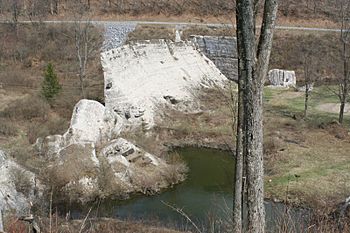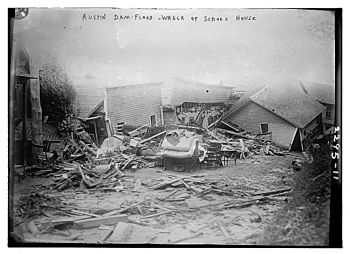Austin Dam failure (Pennsylvania) facts for kids
Quick facts for kids Austin Dam |
|
|---|---|

Remnants of Austin Dam in 2008
|
|
| Location | Keating Township, Potter County, near Austin, Pennsylvania |
| Opening date | December 1909 |
| Demolition date | September 30, 1911 |
| Operator(s) | Bayless Pulp & Paper Company |
| Dam and spillways | |
| Impounds | Freeman Run |
| Height | 50 feet (15 m) |
| Length | 540 feet (160 m) |
| Reservoir | |
| Creates | Austin Dam Pool |
| Total capacity | 200,000,000 US gallons (760,000,000 L) |
|
Austin Dam
|
|

School house after dam disaster
|
|
| Location | PA 872, Austin, Pennsylvania |
| Area | 1.3 acres (0.53 ha) |
| Built | 1911 |
| Built by | Hatton, T. Chalkey |
| NRHP reference No. | 86003570 |
| Added to NRHP | January 15, 1987 |
The Austin Dam, also known as the Bayless Dam, was a concrete gravity dam in the Austin, Pennsylvania area that served the Bayless Pulp and Paper Mill. Built in 1909, It was the largest dam of its type in Pennsylvania at the time. The catastrophic failure of the dam on September 30, 1911 caused significant destruction and loss of life in Freeman Run Valley below the dam.
History
In 1900, George Bayless, owner of Bayless Paper, built a paper mill in the Freeman Run Valley. By 1909, the company realized that occasional dry seasons required a more reliable water source. After finding a small earthen dam to be inadequate, the T. Chalkey Hatton firm was commissioned to build a large concrete gravity dam across the valley. The dam was 50 feet (15 m) high, 540 feet (160 m) long and cost $86,000 to construct. It was designed to be thirty feet thick, but was built only twenty feet thick. Because it was deemed too expensive, an underground vertical concrete slab, which had been designed to prevent water seeping under the dam through the soil the dam sat on, was not built, on Bayless's orders. At the time, there were no state regulations or requirements in Pennsylvania about the building of dams.
The inhabitants of the town of Austin, Pennsylvania downstream from the dam, referred to it, with Bayless's encouragement, as "The dam that could not break."
Within only a few months of its completion, problems were detected. Water was seeping under the dam, which also bowed more than 36 feet (11 m) under the pressure of the water it was holding, and the concrete started cracking. The bowing was alleviated by using dynamite to blast a 13-foot (4.0 m) space for the excess water to spill over. The cracking was claimed to be normal because of the drying cement.
On September 30, 1911, a holiday, after a week of rainstorms which raised the level of the reservoir to only two feel below the overflow level, the dam failed. Part of the structure slid down approximately 50 feet (15 m), while another opened like a door, allowing the impounded water to flow freely down the narrow valley. The wall of water destroyed the paper mill, as well as much of the town of Austin, which was so deeply covered by water in places that only church steeples could be seen. Due to the slope of the valley, the east side of the town received more damage.
There were around 3,000 people in Austin that day, and the catastrophic failure of the dam resulted in the deaths of 78 of them, and approximately $10 million in property damage. A lady located upstream from the town, saw the failure coming and warned the town, saving many lives. A young girl named Mary Fran Simmons, a new immigrant from Galicia, warned many of the townspeople about the impending disaster with her extremely limited English, simply pointing and repeating, "Dam! Dam!"
The paper mill and dam were subsequently rebuilt, but the mill was lost in a fire in 1933. A new dam was built, but it also failed, in 1942, with no loss of life. The dam was not replaced after the second failure.
Legacy
The victims of the dam break are commemorated in the Austin Dam Memorial Park.
The remains of the failed first dam still stand. The ruins consist of a series of broken sections extending east to west across the Freeman Run Valley. There are five upright sections and two large and several smaller toppled sections. The site was added to the National Register of Historic Places in 1987.



